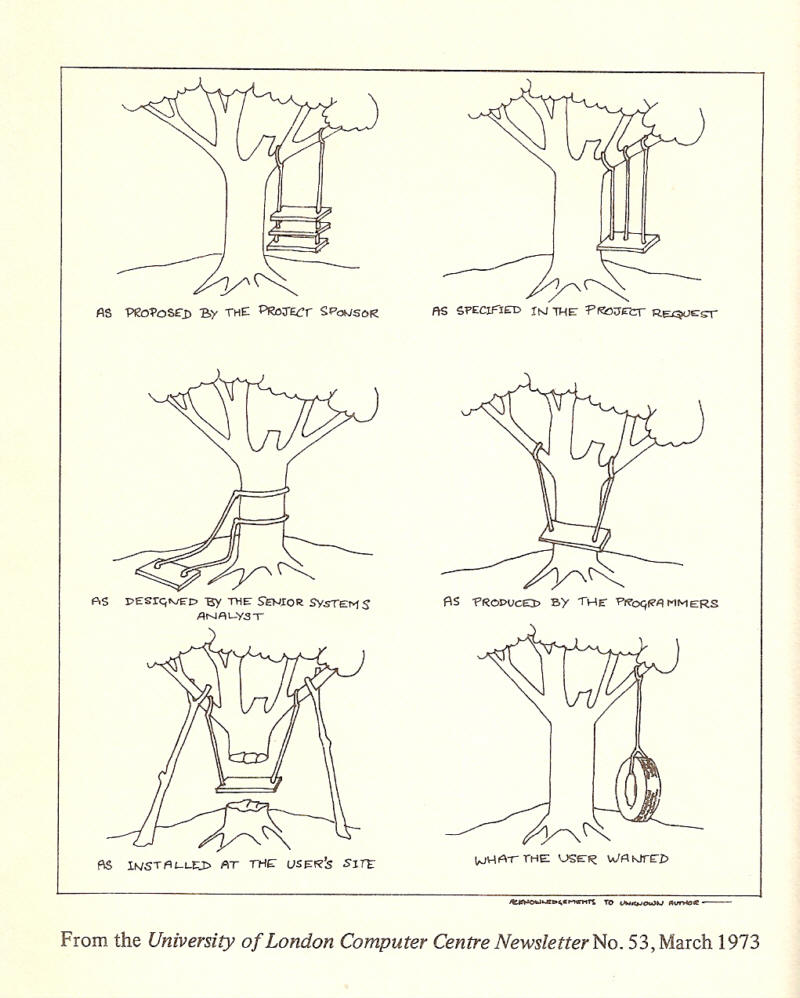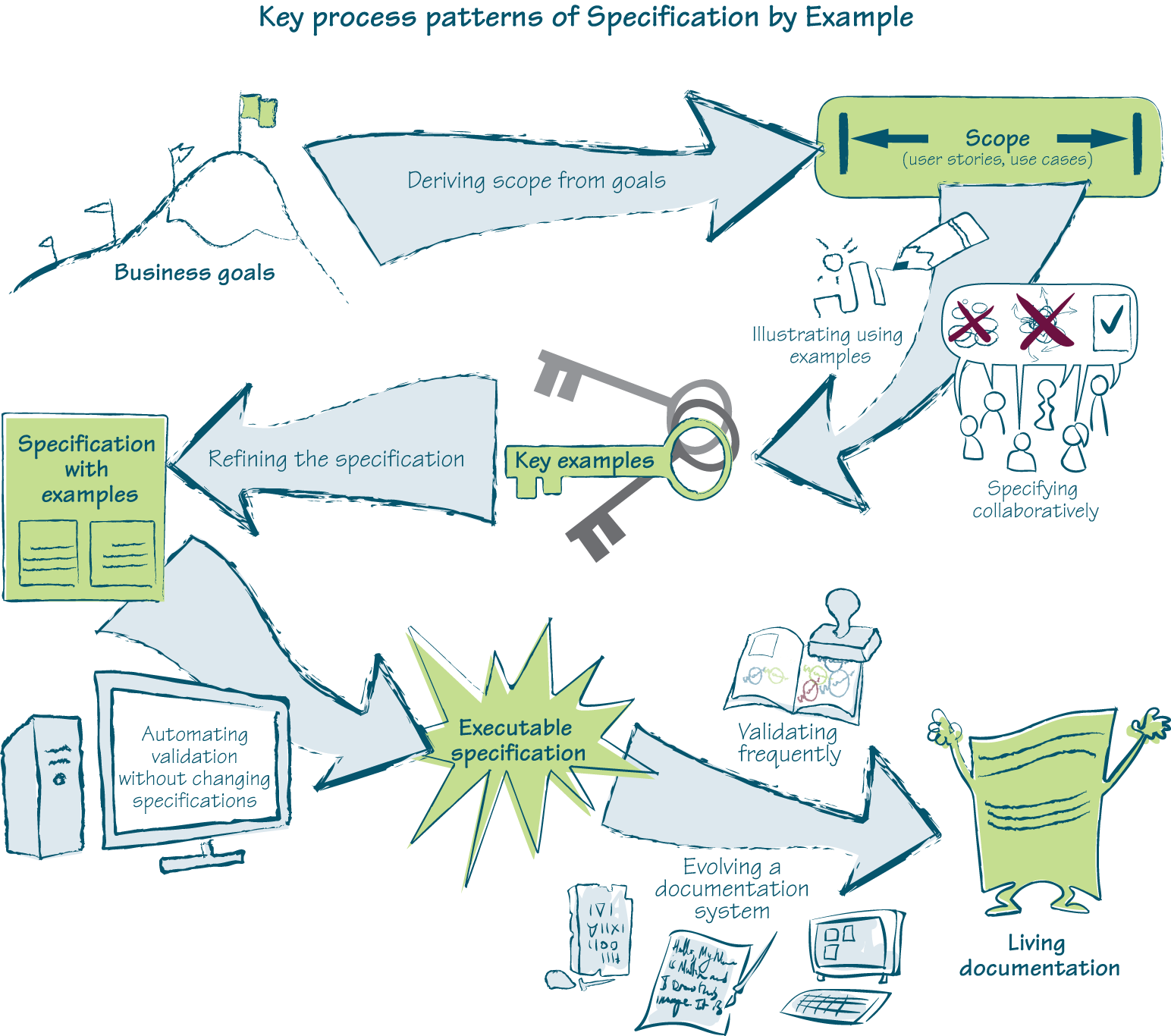Specification by example - book review
Posted on 21 February 2023 in Books • 4 min read

Merriam-Webster dictionary defines specification as
- The act of specifying - naming or stating explicitly or in detail.
- A detailed, precise presentation of something or a plan or proposal for something.
I think of specification as a definition of what the system is expected to do. Ah, if only systems always behaved as they were supposed to!
You darn well know, how that happens. First comes the business, with brilliant or not-so ideas. "We are going to make a new product! It will increase our revenue! ... [an hour later] and the button text should be in red!". The Business Analysts mince that into a Business case™. The POs scrutinize the case into user stories. The QA write acceptance criteria. Finally, the developers start implementing. But the business has already given the teams a detailed vision of how things should be, so there is not much thinking on the way, just turning JIRA tickets into code. There is even no need to roll it out in small chunks to the end customer - the business already knows what the customer wants... This half a century old illustration has not aged by a single second:

Gojko Adzic analyzed the software industry fallacies that lead to such a result. He found out that how companies deal with these fallacies is very much alike. The methods and processes are shared by the most successful teams that he interviewed while researching for the book. He talks of these methods as a set of process patterns that facilitate change in software products to ensure the right product is delivered effectively.
The foundation of every key pattern is collaboration. Gojko noticed that the "handover" journey of specifications through business people, product managers, developers, and QA is full of misunderstanding, ambiguity, information losses, errors and unnecessary work. "Specification by example" teaches how to build a shared understanding between everyone involved in the software creation process. It then demonstrates how to translate the shared understanding into specification documents, leverage them for continual system testing, and produce up-to-date documentation that evolves with the system.
Key process patterns in a tiny nutshell
A successful team begins by deriving scope from a customer's business goals. They collaborate to define the scope that will achieve the goal. The business representatives explain the intent and the value of the feature, so that everyone understands what's needed. Then, the team works with the business to determine the solution.
The teams collaborate and specify the solution together with the business people. Specifying collaboratively allows to utilize the expertise of stakeholders, gather different ideas about the solution and make everyone more engaged.
The stakeholders tightly work together to illustrate specifications using examples. They identify the key examples which unambiguously define what the software needs to do. They’re both the target for development and serve an evaluation criterion to see whether the development is done.

Key examples are a great starting point for creating specification, but they are not specification yet. Gojko emphasizes, that the common reason for teams to fail with Specification by Example - is not taking the time to process the raw key examples. Successful teams don’t use raw examples; they refine the specification from them. The teams carve out the essence of a key example, discard the unnecessary details and turn it into a clear definition of the desired system behaviour.
Note
Ideally, a specification with examples should unambiguously define the required functionality from a business perspective but not how the system is supposed to implement it.
A good specification, with examples, is effectively an acceptance test for the described functionality.
Automating the validation process is a proven way to avoid the bottlenecks of manual testing. What's important is that the teams validate without changing specifications. Otherwise, all the value of refining specifications is lost. Such automated, comprehensible and accessible to all the team members specification with examples becomes an executable specification.
When the validation process happens frequently, the stakeholders are sure that the software works according to the specification. However, how and in which form can they access the verification results? Hence the team continues sharpening the executable specifications and organises the verification output to provide all stakeholders a consistent, easy-to-understand and up-to-date living documentation.
Thoughts
Specification by Example is Behaviour-Driven Development. Gojko Adzic avoided the term since it was too ambiguous, and the meaning was changing all the time. It's been almost fifteen years since the book was written, and BDD is still ambiguous and misunderstood by large and small companies alike.
In one company, the team was participating in meetings with the clients, and together they derived scope from the business goals. They even documented the key examples that the customer provided. But it never went further - the specifications were extracted to JIRA tickets hierarchy and remained there never to be seen again, once the tickets got closed.
In another company, the user stories were extracted into Cucumber-based behaviour tests. But these tests got written AFTER the implementation in code! They have reflected how developers implemented the software, not how it was supposed to behave.
The third company used Cucumber for contract testing of HTTP API. That nicely fits into "101 ways of abusing Given, When, Then".
Least to say, that none of these companies had living documentation.
"Specification by Example" tells the story of teams and companies that succeeded in BDD. Gojko first talks about the obstacles that the teams should go through to change the mindset about BDD. He continues with a detailed explanation of every key pattern - every pattern has a designated chapter. The last six chapters of the book are the case studies, which narrate the companies journey from waterfall and "agile-ish" development processes to specification by example.
To my shame, I have yet to build a system that incorporates all the key patterns described in the book. And I am eagerly looking forward to it!